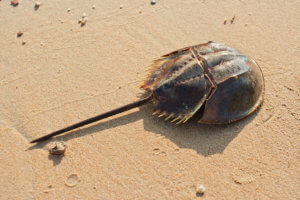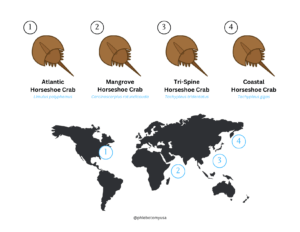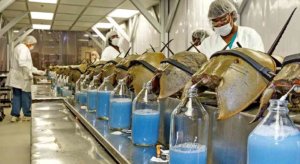04 Sep The Amazing Blue Blood of Horseshoe Crabs
 Horseshoe crabs are special creatures with a secret: their unique blue blood. This blood isn’t just pretty to look at; it does an essential job that helps keep people safe.
Horseshoe crabs are special creatures with a secret: their unique blue blood. This blood isn’t just pretty to look at; it does an essential job that helps keep people safe.
Why Their Blood is So Special
Unlike most animals with red blood, horseshoe crabs have blue blood. This blue blood can spot dangerous germs that might make humans sick. Because of this, doctors and scientists use the crab’s blood to ensure medicines and other tools are safe for us.
How Horseshoe Crab Blood Works
Inside their blue blood, horseshoe crabs have a powerful part called LAL. For the crab, LAL acts like a superhero. If any harmful germs enter their body, the LAL spots them immediately. Then, it clots around these germs, capturing them and preventing them from spreading and causing harm.
For humans, this ability is a game-changer. Scientists noticed how the LAL can detect even the tiniest amounts of dangerous germs. So, they began using horseshoe crab blood to test if medicines, vaccines, and even some medical tools are free from harmful germs, ensuring they’re safe for us to use.
The Challenges They Face
While their blood is very valuable, it has put the horseshoe crabs in danger. Taking their blood is a tricky process. Fishermen catch the crabs and transport them to labs where scientists remove their blood. Once the blood has been removed, the crabs are transported back to the ocean. But this can sometimes hurt the crabs. In fact, many crabs don’t survive after this.
It’s even more challenging for the crabs in some areas, like Asia. There, after scientists take their blood, the crabs are eaten instead of being returned to their homes in the water. Fishermen also use horseshoe crabs for bait. Additionally, their habitats are disappearing, and birds eat their eggs. Because of these issues, we might see fewer and fewer horseshoe crabs in the future.
Will Horseshoe Crabs Go Extinct?
The American horseshoe crab is listed as vulnerable on the IUCN Red List of Threatened Species. This means they’re at risk, but rules are in place to help keep them safe. Thanks to these efforts, some crab populations are growing, though others are still in danger.
In Asia, the situation is not as hopeful. One of Asia’s native species is already classified as endangered and has disappeared from places like Taiwan. It might also disappear from other regions like Hong Kong soon. The other two species in Asia are also in danger.
Finding Better Ways to Help
Though horseshoe crabs are in danger, there is hope. Some companies have begun making a synthetic version of their blue blood to protect the horseshoe crabs. This means we can still ensure our medicines are safe without harming the real crabs. Though this version is not widely used yet, it’s a change that could save many crab lives.
In conclusion, horseshoe crabs are amazing animals with life-saving blue blood. But they face dangers because of it. It’s up to us to find ways to keep both people and crabs safe.


